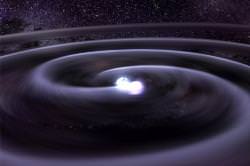There are a few ways that stars can go kaboom, and each variant is different enough that astronomers can figure out what kind of object detonated as a supernova. But when a bizarre explosion was detected last year, it left astronomers puzzled. Now, it looks like SN 2006gz might have been caused by two white dwarfs colliding together.
Millions of years ago, there were two regular stars in a binary system, orbiting one another. Over time, one, and then the other ran out of hydrogen fuel, bulged up as red giants, and then settled down to live out their futures as slowly cooling white dwarfs. But instead of billions of years of quiet cooling, the two stars had decaying orbits. They spiraled inward, and finally collided, detonating as supernova 2006gz.
When SN 2006gz was first discovered last year, astronomers thought they were dealing with a type Ia event. This is where a white dwarf is in a binary system with another star. Like a vampire, the white dwarf feeds on material from the companion star until it reaches 1.4 times the mass of the Sun. This magic point, called the Chandrasekhar limit, is the upper limit of mass a white dwarf can have. And when that limit is reached, the white dwarf detonates as a supernova, visible for billions of light years.
The problem is that SN 2006gz seemed to be too bright. In other words, it must have gotten more mass than the Chandrasekhar limit before detonating. It also had the strongest spectral signature of unburned carbon ever seen.
And that was the key. Mathematical models suggested that colliding white dwarfs would generate this specific signature of unburned carbon. They also suggested that an explosion should contain evidence of compressed layers of silicon, created during the explosion and then compressed during the shockwave that rebounded from the surrounding layers of carbon and oxygen – this too was seen.
Thanks to good observations, SN 2006gz was relatively easy to recognize as a collision between white dwarfs. But this event might be more common in the Universe, and astronomers will need to go back and carefully analyze supernovae on record to see if they’ve been wrongly categorized.
Original Source: CfA News Release

